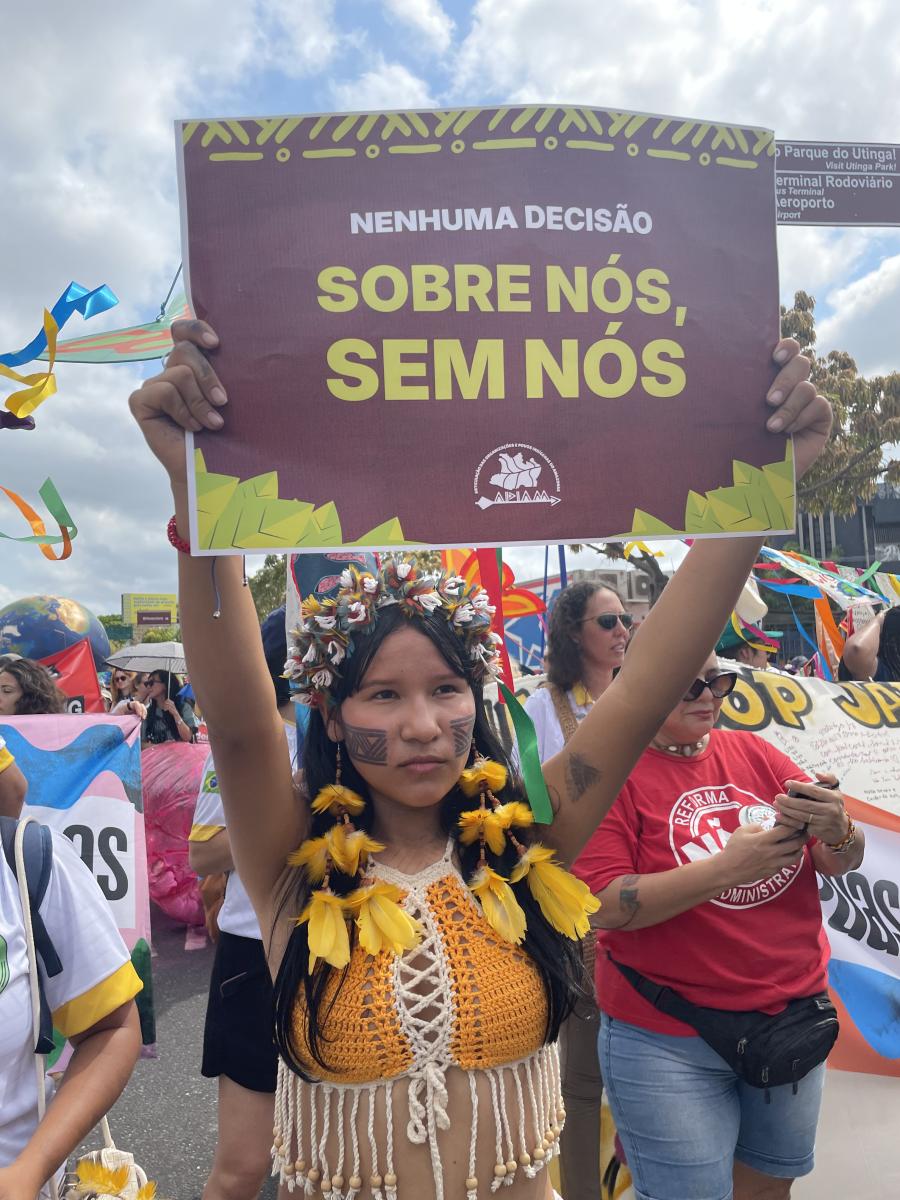When the leaders of the present government of Brazil assumed their posts. They inspired hope with promises reforms and transformations. The Indian peoples and their supporters anticipated a more democratic behavior in the conducting of government indigents policy, the effective demarcation of some territories where there have been conflicts, and the punishment of assassins and aggressors against Indians.
However, in September 1985, after six months of civil government, the Indigenous missionary Council (CIMI), in a document distributed to the press, brought attention to a visible worsening of the situation of Indian peoples, often the fruit of commission and connivance of the federal government. The document denounced the use of police repression against Indian communities (Pataxó and Rikbatsa), and the imposition of agreements harmful to Indian interests (as occurred with the Kayabi/Apiaká and Kayapó). In addition, it pointed duly investigated, and the impunity of the murderers of Indians and missionaries.
The plunder of Indian lands and mineral wealth exists with the connivance of the government. For example, in 1986 supporters of indigenous rights petitioned for the repeal of 537 mining permits illegally issued on Indian lands by the director of the National Department of Mineral Production. Although aware of the illegality of these permits and the damage they cause to Indian communities, the government has not yet repealed them. This government omission leaves Indian communities at the mercy of mining companies that deceive their leaders and impose fraudulent agreements to exploit the subsoil of Indian lands. Such "agreements" have already been imposed on the Tukano, Baniwa and Waimiri-Atroari.
Despite all this, the government is developing a strong publicity campaign that aims to portray President Sarney as the "champion of demarcations" of Indian lands. In reality, according to a study undertaken from data of FUNAI and the Ministry of Agrarian Reform and Development, the Sarney government delimited and/or homologated 34 Indian areas with a total area of 8,259,033 ha. nearly always due to the demands of multilateral banks that financed government projects. At the same time, 28 areas, comprising a total of 6,696,805 ha, have had their demarcation procedures suspended for being situated within the frontier strip. In addition, as of January 1987, the status of another 23 areas, making up 4,957,216 ha, also had been paralyzed without a convincing justification.
Indian Areas and the Frontier Strip
The government alleges that he nondemarcation of Indian areas within the frontier strip is linked to issues of national security. According to the government, the Indian population (which numbers approximately 80,000 within this area) does not offer any guarantee of a stable occupation of the frontiers. Thus, it is considered necessary to "clean" the frontier strip of obstacles to the implantation of more permanent investments. At the same time, FUNAI has commissioned the Ministry of Work to undertake a study regulating the use of Indian labor. Without doubt, the official intention is to institutionalize the use of an Indian labor force in official and private enterprises within the frontier strip. In this way, the government will be able to bypass the eventual accusation of leaving the Indians without resources.
Another government argument is that to recognize the territories of Indian communities implies putting under threat the integrity of the national territory, since Indians, in the future, may claim territorial autonomy. However, the government has confessed that its intention is, in face to deny the Indians the minimum indispensable conditions for their cultural reproduction and their own historical project. Depending on a parcel of land that only allows them mere physical survival, the Indian peoples will suffer an open ethnocide since, in order to survive, they will have to renounce fundamental aspects of their culture, including their traditional modes of production.
The guarantee of international frontiers is an unquestionable duty of the government. However, the attention to frontiers cannot infringe on he historical rights of Indian peoples, and the frontier legislation itself does not include any obstacle to the recognition or tribal territories.
Nevertheless, the position officially assumed by the representative of the National Security Council is to not admit the demarcation of areas situated within the frontier strip and to try to impose, in as many areas as possible, the figure of the agricultural colony, which allows the reduction of territorial space destined for the Indians.
Projeto Calha Norte (North Basin Project)
The Project Calha Norte, initiated in June 1985, is a program for the military occupation of an extensive region in northern Brazil, including nearly 14 percent of the Brazilian territory. The area of the project, understood as an "empty space" from the military viewpoint, is inhabited primarily by Indian peoples.
Behind the project is the necessity to create security conditions that will allow major capital investment in the Amazonian frontier. Among the moves in this direction are an increased military presence, including military-related initiatives such as the construction and improvement of airports, the construction of installations for seven new frontier platoons and the rebuilding of quays and ships. The additional amplification of a highway infrastructure and increased production of hydroelectric dams will seriously affect Indian lands. At the same time, there are moves toward a specific definition of indigenous policy "appropriate for the region."
The project does not make explicit the colonization plans and mineral exploration upon which as really conceived, yet the language used by General Denys in a meeting in January 1987 does not leave any margin for doubts. The Indian "obstacle" would by bypassed by a double strategy.
The secretary of the National Security Council, General Bayma Denys, has insisted on the necessity of a consensus about the criterion "reasonable" for the definition of Indian lands. As proposed, the criterion "reasonable" for these sectors would be the adoption of the module of 100 ha per Indian family.
What is really at stake is the reduction of the concept of inhabited Indian land to land economically occupied. At the same time mechanisms are being conceived to engage Indian population as a labor force. Without a territorial space that allows them to maintain their traditional mode of life, the Indians will have no alternative but to accept their engagement and, with it, the process of forced assimilation.
According to the project, all aspects relating to the area are seen through the prism of national security, justifying the intervention of the National Security Council in social, sanitary, educational, power, agricultural and cattle-raising, industrial and indigenous fields.
Thus, two forces are interested in the project: the armed forces, interested in the occupation of the region and in maintaining and increasing the capacity to exercise political control, and the entrepreneurs, interested principally in the mineral potential.
The Project's Pitfalls
The Plan of Development of Amazonia foresees a total cost of $640 million. Some of this money will come from the "Programme of Redistribution of Land and Stimuli for Agricultural Industry in the North, Northeast - PRO TERRA" under the explanation that it is involved in "regional development". This would mean a deviation of public funds that are not being applied to the ends for which they were destined - a fact that could bring about a popular action and representation to the National Congress, as well as a request for preventive action to the Audit Office of the Union.
In addition, the project may create problems of national security, by choosing a "priority and preferential area" - a "strip that borders on five neighboring countries along 6,500 km extension" - in which military resources are concentrated without any consultation of the National Congress thereby creating diplomatic and military tensions.
The project constitutes serious threats to Indian nations, affecting not only the Yanomami nations, but other peoples as well. The allegation that the Project Calha Norte would be a way of preventing the supposed articulations in favor of creating a "Yanomami State" is, to say the least, irresponsible. It is sufficient to remember that the 1979 letter which requested the creation of the Yanomami Park had among its signers many famous Brazilians who could not be accused of conspiring against "national security". The truth is that the suspicion contained in the project benefits mining company interests that desire free access to the riches of the Yanomami subsoil.
By proposing the "definition of an indigents policy appropriate for the region," the project represents a clear violation of the precepts of the Constitution. Decisions of this nature, in relation to FUNAI, have been the object of controversies in various other regions of the country, since they relegate to a secondary plane what should be fundamental - the demarcation. Contrary to the law, the project proposes a program of regional development without the previous consultation of the congress. Without any social control, the project undertakes actions of intervention in the environment. In fact, the project puts the Brazilian state at the service of the actions of private companies in the areas of mineral resources, agriculture and cattle-raising exploitation.
Finally, the project is being carried out without the consultation of regional or state bodies and, principally, without taking into account the inhabitants of the region, as well as the organizations that work in the region (representatives of the civil society) or outside of the region (interests related to the protection of the environment and defense of Amazoina, among others).
Conclusion
The government's initiatives are a strategy that aims to bypass the discussions of the National Constitutional Assembly. If the government is successful, the survival of Indian peoples will be irremediably jeopardized and the Amazonian environment will also suffer. Throughout centuries, tribal groups developed a system of adaptation is an empirical knowledge that will be maintained only if the Indian peoples can preserve their traditional mode of life. And the only way we can have access to this knowledge, that Western science is still far from mastering, is to guarantee the physical and cultural survival of tribal groups. The objective of the government strategy, to force the Indians to give up space for big capital enterprises, disregards the inestimable value of indigenous knowledge about Amazonia.
The Indian peoples of Brazil have never faced such a serious thereat as now. It is urgent that the government recognize the tribal territories, defining them according to the criteria of the Indian communities themselves. The National Constitutional Assembly must be preserved in order that the rights of the Indian peoples be recognized by the future constitution of the country. The Indian peoples of Brazil, alone, do not have the means to face this offensive that is overwhelming them, Brazilian society, in its turn, is submerged in an economic crisis, with little means to take up the Indian cause. For this reason international support is indispensable.
Article copyright Cultural Survival, Inc.


